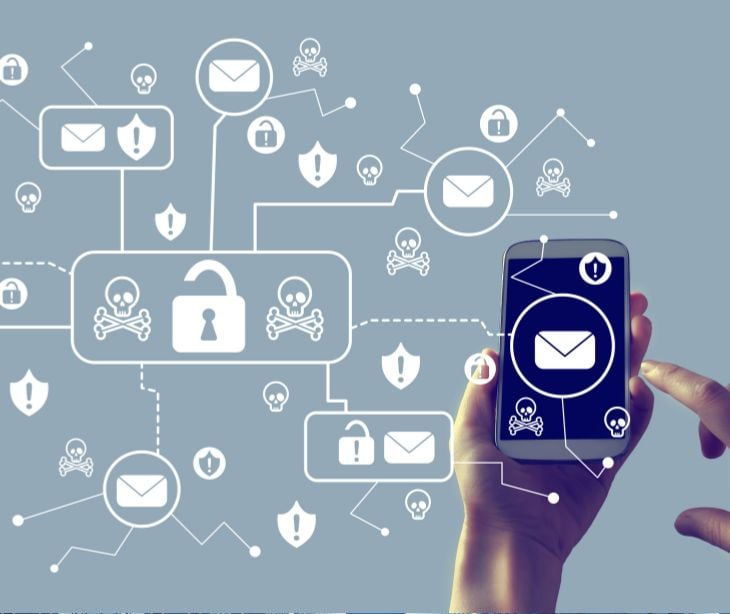
Multimedia messaging (MMS) is not inherently HIPAA compliant, so providers must use secure messaging platforms to safeguard protected health information (PHI) when sending images, videos, and other visual aids.
Accessibility of MMS
Statistica reports “In 2021, mobile users in the United States sent roughly 2 trillion SMS or MMS messages”, showcasing the continued reliance on mobile messaging for communication. The affordability and reach of SMS and MMS make them valuable resources for sending health-related information.
“In addition to the extensive coverage of this method, it lends itself to health messaging because of its scalability at a low cost…” explains News Medical.
Standard messaging and PHI
The Health Insurance Portability and Accountability Act (HIPAA) mandates safeguarding patients’ protected health information (PHI). Traditional text messaging and multimedia messaging services (MMS) lack inherent security features, making them unsuitable for transmitting PHI. More specifically, sending unencrypted messages exposes PHI to unauthorized access during transmission or when at rest, which could lead to HIPAA violations.
For example, sending a patient's X-ray image without encryption could potentially allow a hacker to intercept and view sensitive information, putting the patient's privacy at risk. Furthermore, the provider could face HIPAA fines and reputational damage.
So, providers must implement secure communication methods to protect PHI and comply with HIPAA regulations.
Go deeper: Is SMS messaging HIPAA compliant?
Achieving HIPAA compliant multimedia messages
Patient authorization
Providers must first obtain explicit patient authorization before sending any PHI via electronic communication, including emails and texts. The HIPAA consent form should clearly outline the types of information that might be sent via MMS and how it will be secured. Providers should also explain the benefits of using MMS for educational purposes, medication reminders, or follow-up instructions.
HIPAA compliant platform
Providers must use a HIPAA compliant platform, like Paubox, that encrypts messages and data at rest and in transit. These platforms should offer features like access controls and audit trails for added security. Additionally, only authorized personnel should be able to access patient information, and all communications should be recorded.
Business associate agreements (BAA)
When using a third-party vendor (e.g., platform providers), ensure they are willing to sign BAA. This legally binds them to uphold HIPAA regulations and clarifies the vendor's responsibilities in safeguarding this sensitive data.
Go deeper: What is the purpose of a business associate agreement?
Staff training
Implement training programs to educate staff on HIPAA regulations and the proper use of the chosen platform. Regular training sessions keep staff up-to-date on security protocols and help them understand the consequences of non-compliance.
Authentication
Providers can implement procedures, like two-factor authentication, to verify the identity of the recipient to prevent unauthorized access to patient information.
Minimize identifiable information
Providers should only include the minimum necessary information in multimedia messages. For example, when sending images, providers should take steps to redact any details that could identify the patient. So, providers can use tools to blur faces, names, or other sensitive areas that could compromise patient privacy.
FAQs
Are multimedia messages considered HIPAA compliant?
Multimedia messages can be HIPAA compliant if sent and handled according to HIPAA regulations and guidelines for electronic communication. Providers must use a HIPAA compliant platform that encrypts patients’ sensitive information.
What is two-factor authentication?
Two-factor authentication is a security measure that requires users to provide two different forms of identification to access a system or application, adding an extra layer of security beyond just a password. Users typically input their password and then provide a second form of verification, like a code sent to their smartphone. The extra layer of security makes it more difficult for unauthorized users to gain access.
What are the penalties for HIPAA violations?
Providers can face fines ranging from $100 to $50,000 per violation for civil penalties, and criminal penalties may include fines up to $250,000 and imprisonment for up to 10 years. Additionally, breaches can lead to legal action and reputational damage.
Subscribe to Paubox Weekly
Every Friday we'll bring you the most important news from Paubox. Our aim is to make you smarter, faster.




